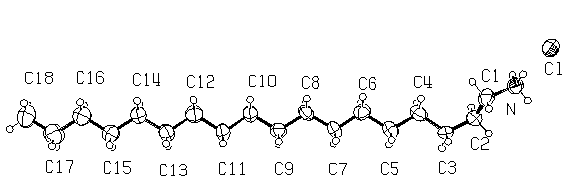
Fig. 2
SINGLE CRYSTAL AND POWDER XRAY DIFFRACTION STUDY OF THE NONINTERDIGITATED VIRGIN STRUCTURE OF nOCTADECYLAMMONIUM CHLORIDE
E.C. Reynhardt1, G.J. Kruger1 and R. Scholtz2
1Department of Chemistry and
Biochemistry, Rand Afrikaans University, P.O. Box 524, Auckland
Park 2006, South Africa.
2Department of Physics, University of
South Africa, P.O. Box 392, Pretoria 0003, South Africa.
Keywords: noctadecylammonium chloride; single crystal
xray diffraction; powder xray diffraction
Depending on the temperature at which crystallization takes
place, noctadecylammonium chloride crystallizes as either an
interdigitated or a noninterdigitated structure. Xray
diffraction intensities of a single crystal with the
noninterdigitated structure were measured on a Siemens SMART
system with a twodimensional CCD detector. The structure was
solved by direct methods (orthorhombic, space group Pna21,
a = 70.905(6), b = 5.4505(5), c = 5.3639(5)
A, Z = 4). A difference Fourier synthesis and refinement
by fullmatrix leastsquares (1) with anisotropic displacement
parameters for all nonH atoms yielded a conventional R = 0.084.
The H atoms were placed in calculated positions and refined as
riding on their connected atoms with isotropic displacement
parameters 1.2 times that of the equivalent value of the heavy
atom. The refinement of the absolute structure parameter
according to the method of Flack (2) gave a value of 0.4(3). This
indicates merohedral twinning, a distinct possibility in a
symmetric structure such as this, where spontaneous resolution
into race mates is unlikely. The chains are packed in a
herringbone structure (Fig. 1) and are not fully extended, but
have a kink between the second and third carbon atoms (Fig. 2).
 |
Fig. 1 |
Fig. 2 |
The average CC distance and CCC angle are 1.507(17) A and 115.2(1.5)°, respectively. The average torsion angle around the CC bonds for C(4) to (17) is 179.1(8)°. The quaternary N atoms and the chloride ions are hydrogenbonded through the H atoms in such a way that each N is surrounded by three chlorine atoms.
A powder diffraction pattern of the noninterdigitated compound
was recorded on a Siemens D5000 diffractometer. Using the atomic
coordinates of the single crystal refinement, a Rietveld
refinement (3) was performed successfully. Although the fit
between measured and calculated patterns, is not perfect, it
illustrates that, by employing sound experimental techniques, a
laboratory powder diffractometer can produce data which are good
enough to refine a crystal structure, such as the present one, to
a point where the resulting atomic coordinates are chemically
reasonable.